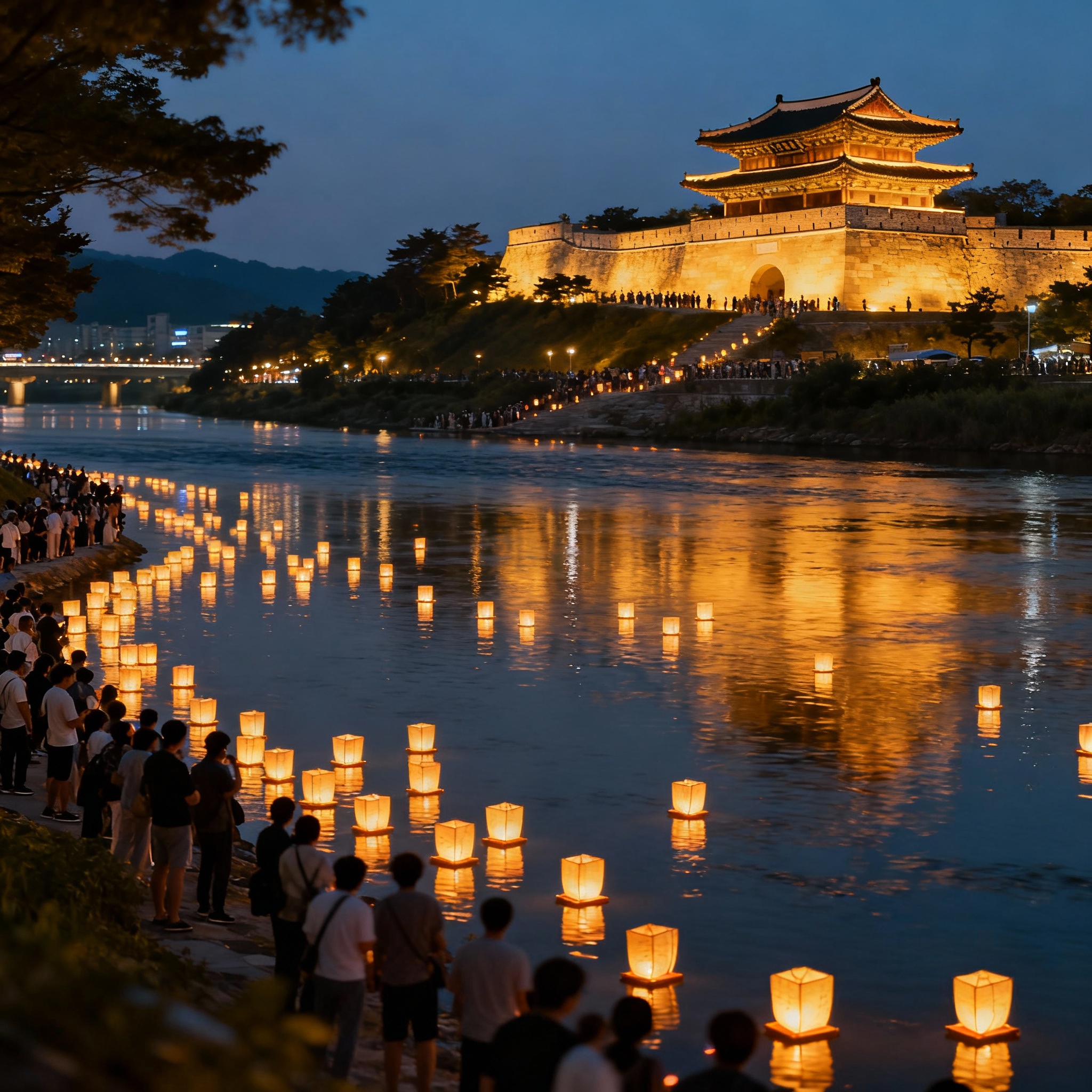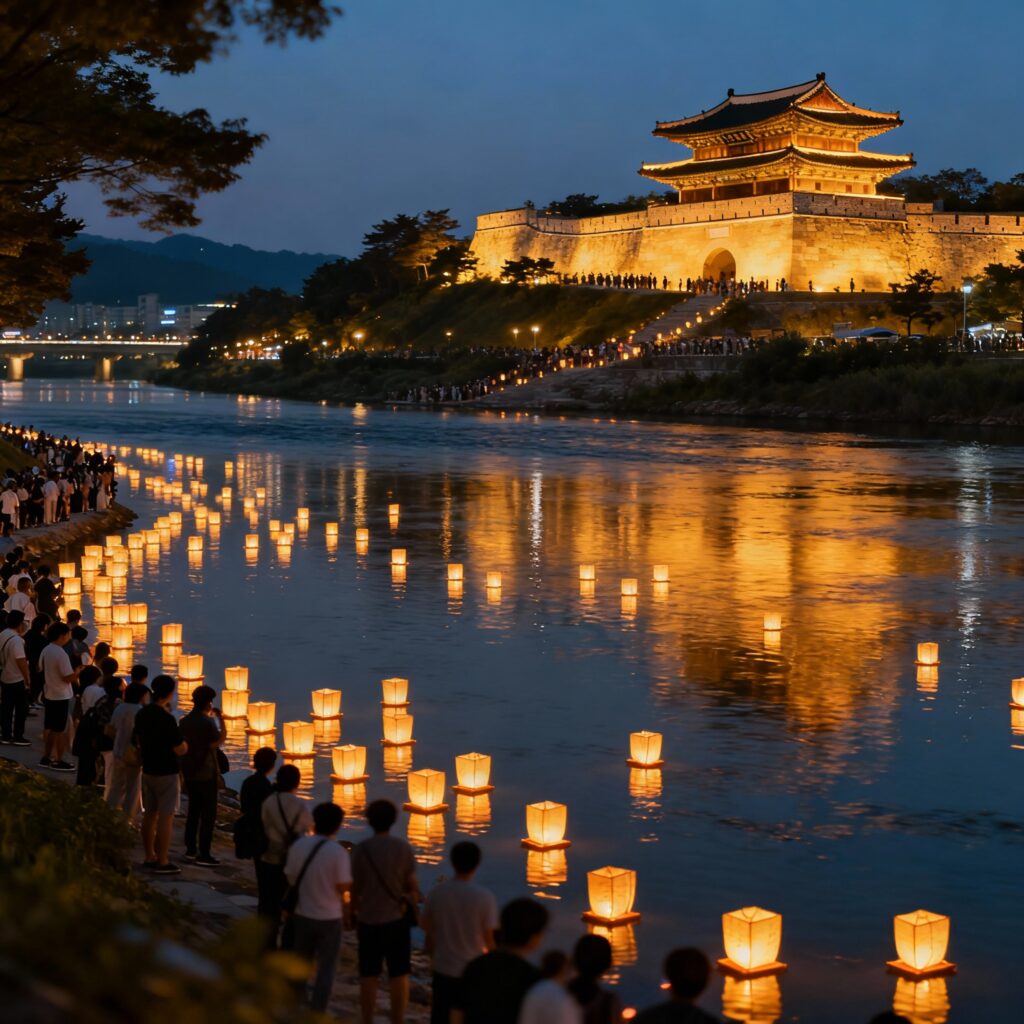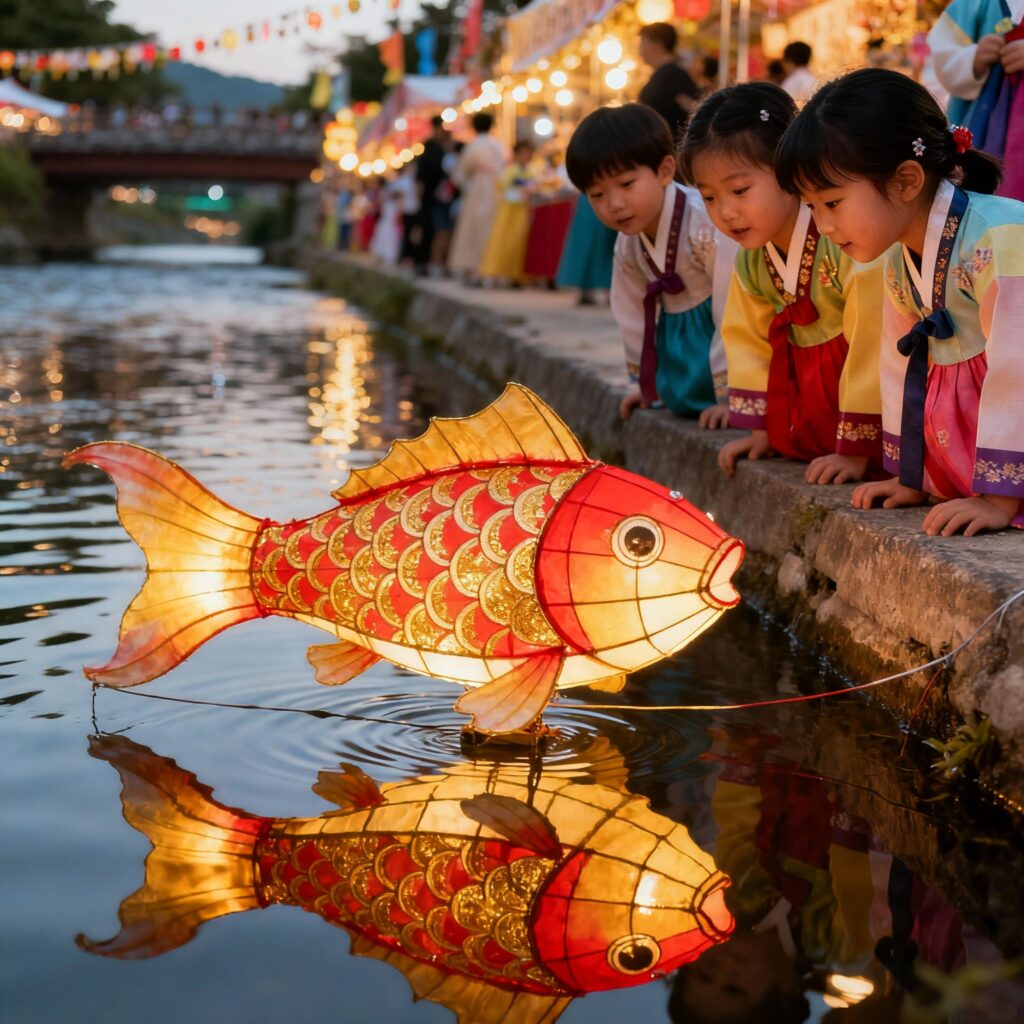
Jinju Lantern Festival 2025 (Namgang Yudeung Festival): A Spectacular Journey Through South Korea’s River of Light
Introduction: Nightfall on the Namgang
The first lantern drifts like a timid star, its paper skin trembling with the breath of the Nam River. Then another comes, and another—vermillion, saffron, moon-white—until the water brightens as if dawn has arrived beneath the bridges of Jinju. Children lean over railings to point at carp-shaped lights gliding past. Elders close their eyes and whisper names of loved ones into the wind. Vendors stir tteokbokki in bubbling red sauce while cameras click in soft syncopation. Above, a crown of fireworks lifts and dissolves into glittering ash, and the city exhales in unison: welcome to the Jinju Namgang Yudeung Festival 2025, one of the most enchanting South Korea lantern festivals.

History: From Signals of War to Rivers of Remembrance
The story begins in the late 16th century, during the Imjin War (1592–1598), when the people of Jinju relied on lanterns—yudeung—as signals and guides in the fog of conflict. Lanterns hung along the fortress walls and floated on the Nam River to communicate troop movements and guard positions. Just as importantly, they illuminated the night for civilians seeking safety and solace. Over time, the lanterns took on a second, more tender duty: honoring the war dead and all those who bore the weight of that turbulent era. What began as a language of necessity became a ritual of memory—a way to send light to the spirits and blessings to the living. Today’s festival preserves this dual legacy: lanterns as both practical beacons and soulful tributes, stitching past to present with a thread of flame.
What Makes the Jinju Lantern Festival 2025 Unique: A City-Sized Light Poem
- River lanterns and floating yudeung: The Nam River is the festival’s grand stage. Thousands of hand-crafted lanterns—lotus blossoms, carp, dragons, tigers, cranes—ride the current, turning water into a living scroll of light.
- Monumental lantern exhibitions: Stroll riverbanks lined with towering illuminated sculptures. Think multi-story pagodas, mythical guardians, and scenes from Korean epics rendered in silk and bamboo.
- Fireworks reflected on water: Fireworks crown select nights, doubling their spectacle in the mirror-still river, as if two skies are celebrating.
- Parades and cultural shows: Mask dance, pungmul drumming, tight formations of hanbok-clad performers—each step a beat in Jinju’s living heritage.
- Fortresses of memory: Jinjuseong Fortress becomes a glowing citadel, its walls traced by lanterns that outline centuries of resilience.
- Hands-on craft: Visitors write wishes on paper slips, tie them to lanterns, and release them onto the current, joining a shared story of hope.
Jinju Lantern Festival 2025: Dates, Highlights, and What’s New
- Dates: The Jinju Namgang Yudeung Festival typically spans late September to mid-October. For 2025, plan for early October prime nights, with the main weekend programs concentrated Friday through Sunday. Check the official Jinju city or festival website for precise date announcements as the season approaches.
- Opening Ceremony on the River: Expect a dramatic lantern ignition sequence along the Nam River edges and bridges, followed by an inaugural fireworks flourish.
- Nightly Lantern Drifts: Each evening brings themed releases—memorial nights, family blessing nights, and wish-writing hours—so every visit feels fresh.
- Lantern Exhibition Zones: Multiple zones showcase regionally inspired lantern art, including traditional Joseon motifs, marine life, constellations, and contemporary designs.
- Cultural Stages: Rotating lineups of pansori, folk dance, samulnori percussion, and fusion performances create a soundtrack of heritage and innovation.
- 2025 Innovations:
• Interactive AR wayfinding and story plaques accessible via QR codes near major installations.
• Sustainability pavilion featuring upcycled lantern materials and river ecology education.
• Family Lantern Lab—guided mini-workshops where kids assemble small LED-safe lanterns to carry along the promenade.
• Photo bridges: selected pedestrian bridges fitted with low-glare lighting rails designed to improve night photography without washing out the lantern glow. - Finale Weekend: A synesthetic closing ceremony blends choral music, percussion, water projections, and a final, serene lantern farewell to the river.
Step-by-Step Visitor Guide
1) Planning and Getting There
- Where is Jinju? Jinju sits in South Gyeongsang Province, southwestern side of the Gyeongnam region.
- By Air: Fly into Gimhae International Airport (Busan) or Gimpo/Incheon (Seoul). From Busan, take an intercity bus or KTX/SRT train to Jinju. From Seoul, KTX to Jinju Station via Jinju-bound services (with possible transfers at Miryang or Jinju-bound express, depending on timetable).
- By Rail: KTX and SRT lines offer fast services; reserve seats early during the festival window.
- By Bus: Major intercity terminals (Seoul Express Bus Terminal, Nambu Terminal, Busan Seobu) run frequent services to Jinju Intercity Bus Terminal.
- Local Transit: From Jinju Station or bus terminal, local buses and taxis connect to riverfront areas near Jinjuseong and key viewing spots.
2) Where to Stay: Accommodation Strategy
- Book early: The Jinju Lantern Festival 2025 draws large domestic and international crowds. Reserve 1–2 months in advance.https://worldfestive.com/
- Neighborhoods:
• Near the Nam River/Jinjuseong Fortress for walkable access.
• Jinju City Center for restaurants, cafés, and late-night snacks.
• Outskirts/Business Hotels for quieter nights and easier parking. - Types:
• Hanok-style guesthouses for traditional ambience.
• Modern hotels/business inns for convenience.
• Hostels and pensions for budget-friendly groups. - Pro tip: Look for properties with river views—some balconies offer a private light show.
3) How to Join the Lantern Releases
- Find a Wish Lantern Booth: Official booths sell or distribute lanterns or wish slips. Staff provide markers and brief instructions.
- Write Your Wish: Keep it short, heartfelt, and legible. You can write in English or Korean.
- Lighting and Safety: Many lanterns use LED candles for safety. Follow staff guidance to place candles correctly and secure paper seams.
- Release Points: Designated platforms along the riverbank allow staggered releases to prevent congestion.
- Respect the Flow: Don’t wade into the river; release and step back so the next visitor can approach.
- Volunteer Guides: Look for volunteers in visible vests if you need help or translation.
4) Best Photo and Viewpoint Tips
- Blue Hour Magic: Arrive 30–45 minutes before full darkness to capture silhouettes of bridges and the first lanterns.
- Reflections Rule: Frame shots to double the spectacle—water reflections are half the story.
- Keep ISO Moderate: Use a tripod or stabilizer; aim for ISO 400–800 with longer exposures to preserve color richness.
- Bridges as Frames: Use bridge arches and railings to frame floats. The pedestrian bridges near Jinjuseong offer iconic angles.
- People + Light: Don’t just shoot the river—capture faces illuminated by lantern glow for human warmth.
- Fireworks Nights: Scout a spot with an unobstructed river view 20–30 minutes ahead of the crowd.
5) Food, Night Markets, and Where to Graze
- Riverfront Night Market: Grills sizzle with dak-kkochi (chicken skewers), hotteok stuffed with cinnamon-syrup, fish-shaped bungeoppang, and sweet potato sticks.
- Local Specials: Try Jinju bibimbap (noted for generous toppings), Jinju-style beef soup, and fresh river fish dishes.
- Winter Warmers: Odeng (fishcakes) in broth, piping-hot mandu, and yuzu tea for cool evenings.
- Cafés and Dessert: Bakeries sell lantern-shaped cookies; cafés serve limited-time “Namgang Latte” with caramel art.
6) Safety and Etiquette
- Crowd Sense: Move with the flow; avoid stopping mid-bridge.
- Lantern Care: Hold lanterns upright and away from hair or scarves; LEDs minimize hazards.
- Children: Keep wristbands with parent contact info; prearrange meeting points.
- Weather: Light layers; evenings can be cool by the river. Bring a compact poncho.
- Accessibility: Ramps and smooth riverwalks are present in many zones; check maps for accessible viewing decks.
- Waste and Recycling: Use the clearly marked stations; follow green volunteers’ directions.
Local Voices: Stories from Along the River
- The Veteran Craftsman: “When I bend bamboo for a carp lantern,” says Mr. Kim, a lantern maker from a family that has practiced for three generations, “I’m shaping a river current you can hold. Every strip remembers a wave.”
- A Mother and Daughter: “We write one wish each year,” says Mrs. Park, pressing her daughter’s mittened hand. “Mine is for her to grow brave. Hers is for me to laugh more.”
- A University Volunteer: “I translate wishes,” laughs Jisoo, a student. “Most are love, some are exams, and a few are for world peace. The river holds them all without judgment.”
- A Percussionist: “Drums talk to water,” says Mr. Choi from a samulnori troupe. “You’ll hear the river answer during the finale.”
Art, Crafts, and Souvenirs from Jinju
- Handcrafted Lantern Kits: Take-home kits include pre-cut hanji paper, bamboo ribs, and LED cores—perfect for a post-trip craft night.
- Hanji Stationery: Lantern patterns printed on traditional Korean mulberry paper—cards, notebooks, and bookmarks.
- Miniature Fortress Models: Wooden or paper models of Jinjuseong make thoughtful, educational gifts.
- Textile Charms: Embroidered pouches (bokjumeoni) symbolizing luck; many stalls sell limited festival editions.
- Local Tea and Snacks: Citron tea jars, rice crackers, and artisanal candies shaped like lotus or carp.
Family-Friendly Activities and Kids’ Experience
- Lantern Lab Workshops: Short sessions teach basic folding and safe lighting; kids leave with a palm-sized glow companion.
- Storytime by the Water: Volunteers read folktales in Korean and English, with illustrated lanterns acting as props.
- Scavenger Hunt: A festival map marks animal lanterns; children collect stamps at each sighting for a small prize.
- Quiet Corners: Designated calm zones with seating and dimmer light for sensory-sensitive kids.
- Hands-On Drumming: Supervised try-outs with small janggu drums give kids rhythmic fun between lantern releases.
Meaning and Symbolism: What a Lantern Carries
In Korean culture, lanterns are vessels of intention. The glow represents clarity and guidance; the act of releasing one is a gesture of letting go while sending forward a wish. Lotus lanterns nod to purity and renewal; carp suggest perseverance and luck; cranes, longevity and peace. During the Jinju Namgang Yudeung Festival, this symbolism becomes communal. As thousands of lights drift together, wishes harmonize into a single luminous current, turning private hopes into a shared ceremony of belonging.
Comparisons with Other Asian Lantern Festivals
- Pingxi Sky Lantern Festival (Taiwan): In Pingxi, lanterns take to the sky—paper balloons lift wishes into the night. Jinju, by contrast, writes its poetry on water. Both share the language of hope, but Jinju’s riverine canvas adds reflections and fortress silhouettes.
- Yi Peng and Loy Krathong (Chiang Mai/Thailand): Yi Peng releases sky lanterns; Loy Krathong floats krathong on waterways. Jinju aligns more closely with the water-borne tradition, yet its monumental sculptural lanterns and fortress backdrop give it a uniquely Korean profile.
- Hoi An Full Moon Lantern Festival (Vietnam): Streets go dark to let lanterns and candles rule the night. Jinju similarly prioritizes ambience, but scales up with parades, fireworks, and large-scale installations.
- Nagasaki Lantern Festival (Japan): Urban streets glow with Chinese New Year motifs and red lantern canopies. Jinju emphasizes historical remembrance and river rituals, creating a more contemplative tone amid spectacle.
Sustainability at the Modern Jinju Festival
- LED Illumination: Widespread LED use reduces fire risk and energy consumption while preserving color quality.
- Reuse and Upcycling: Large sculptural frames are reused annually; damaged hanji sections are repulped for craft workshops.
- River Stewardship: Post-event river sweeps and floating barriers capture stragglers; volunteer teams conduct shoreline cleanups at dawn.
- Recycling Stations: Clearly labeled bins and staff guidance keep paper, plastic, and organic waste separate.
- Low-Glare Photography Lights: 2025’s photo bridges demonstrate how design can serve both safety and ambience without pollution.
- Education Pavilions: Exhibits explain hanji production, bamboo cultivation, and the festival’s wartime origins to deepen respect for resources and history.
Practical Itinerary Suggestions
- One-Night Sampler (Arrive afternoon): Check in near the river, early dinner at the night market, blue-hour photos, opening lantern release, fireworks, late dessert and coffee.
- Two Days (Deeper Dive): Day 1 for exhibitions and crafts; Day 2 for fortress tour, storytelling, and a second lantern wish night.
- With Kids: Book workshops early, plan a short nap before evening events, and stake out a bridge-side zone with easy exit routes.


Let the River Remember
Stand by the rail and watch the current take your wish. The lights ahead belong to strangers, but for a few heartbeats their hopes are your own. This is the promise of the Namgang Yudeung Festival: that memory can be celebratory, that beauty can be communal, and that in the glow of a handmade lantern, the distance between past and present, self and neighbor, grows tender and small. When you leave Jinju, the river keeps flowing—but a little part of your light goes with it.



Leave a Reply